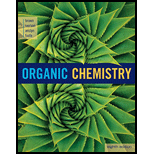
(a)
Interpretation:
Similarities between the mechanism of deamination of
Concept Introduction:
Tiffeneau–Demjanov reaction: It is an organic reaction where 1-aminomethyl-cycloalkanol gets converted to an enlarged cycloketone by reacting with nitrous acid.
Pinacol rearrangement: For all glycols Pinacol rearrangement occurs. Unsymmetrical vicinal
Step 1: Add proton (protonation of Pinacol using acid catalyst).
Step 2: Break a bond to give a stable molecules or ions (formation of carbocation).
Step 3: 1, 2-shift (migration of substituent from
Step 4: deprotonation occurs (take a proton away).
(b)
Interpretation:
Reason for the expansion of ring in the deamination of
Concept Introduction:
Tiffeneau–Demjanov reaction: It is an organic reaction where 1-aminomethyl-cycloalkanol gets converted to an enlarged cycloketone by reacting with nitrous acid.
Pinacol rearrangement: For all glycols Pinacol rearrangement occurs. Unsymmetrical vicinal diols reveal that
Step 1: Add proton (protonation of Pinacol using acid catalyst).
Step 2: Break a bond to give a stable molecules or ions (formation of carbocation).
Step 3: 1, 2-shift (migration of substituent from
Step 4: deprotonation occurs (take a proton away).
(b)
Interpretation:
Concept Introduction:
Tiffeneau–Demjanov reaction: It is an organic reaction where 1-aminomethyl-cycloalkanol gets converted to an enlarged cycloketone by reacting with nitrous acid.
Trending nowThis is a popular solution!

Chapter 23 Solutions
Organic Chemistry
- :0: :0: Select to Add Arrows :0: (CH3)2NH :0: ■ Select to Add Arrows :0: :0: (CH3)2NH ■ Select to Add Arrowsarrow_forwardDraw the product of the following H action sequence. Ignore any inorganic byproducts formed. 1. (CH3CH2)2CuLi, THF 2. CH3Br Q Atoms, Bonds and Rings H Charges ㅁarrow_forwardPlease help me with this the problem is so confusingarrow_forward
- 14 Question (1 point) Disiamylborane adds to a triple bond to give an alkenylborane. Upon oxidation with OH, H2O2, the alkenylborane will form an enol that tautomerizes to an aldehyde. In the first box below, draw the mechanism arrows for the reaction of disiamylborane with the alkyne, and in the last box draw the structure of the aldehyde. 4th attempt Feedback i > 3rd attempt OH, H2O2 i See Periodic Table See Hintarrow_forwardanswer with mechanisms and steps. handwritten please!arrow_forwardHello I need some help with Smartwork. For drawing structure B, I know the correct answer is CH₃B₂, but when I try to type it in, it keeps giving me CH₄BH₃ instead. Do you know how I should write it properly? Should I use a bond or something else?arrow_forward

 Organic ChemistryChemistryISBN:9781305580350Author:William H. Brown, Brent L. Iverson, Eric Anslyn, Christopher S. FootePublisher:Cengage Learning
Organic ChemistryChemistryISBN:9781305580350Author:William H. Brown, Brent L. Iverson, Eric Anslyn, Christopher S. FootePublisher:Cengage Learning

